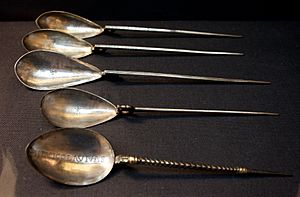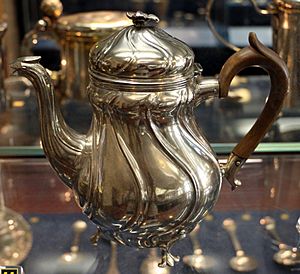Household silver facts for kids

Household silver or silverware means things like plates, forks, spoons, and other items for your home that are made from silver. People sometimes call it "the silver" or "the plate."
These items can be made from pure silver, silver with a gold coating, or silver that's been specially treated. Sometimes, people buy silver items in sets, like a set of silver candlesticks or a silver tea set.
Long ago, silverware was used for eating, but also for dressing rooms. Fancy "toilet services" were sets of many silver pieces for a lady's dressing table. These sets were very popular from the 1650s to about 1780.
History of Silverware

Rich people in most ancient cultures loved to eat from dishes made of precious metals like silver. However, in China and Japan, they preferred beautiful lacquerware or porcelain dishes instead.
In Europe, from ancient times until the 1700s, rich families ate from silver. People who were not as wealthy used dishes made of pewter or latten (a type of brass).
Another old way to serve food was on a "trencher." This was a big flat piece of bread or wood. In the Middle Ages, people often served food this way. The bread could even be eaten after the meal. Even rich families used trenchers until the 1650s in France.

How much silverware someone owned depended on how rich they were. The wealthier a person was, the better quality and more pieces of silverware they had. Sometimes, rules called sumptuary laws even controlled what materials people could use for their dishes.
In the Middle Ages and early modern times, much of a rich person's money was often in their silver items. What wasn't being used for a meal was often displayed on a special cabinet called a dressoir or buffet in the dining hall.
For example, at the wedding of Philip the Good, a duke, in 1429, there were two huge display cabinets. Each was 20 feet long and held five rows of silver items. King Charles V of France (who ruled from 1364 to 1380) had records showing he owned 2,500 pieces of silver!
Sadly, much of this old silver was melted down to pay for wars or new buildings. Very few of the huge amounts of silver from the Middle Ages still exist today. The French Royal Gold Cup in the British Museum, made of solid gold with enamel and pearls, is one of the rare exceptions.
Caring for Silverware
Silver needs a lot of care because it can get dull or discolored, which is called tarnishing. It must be polished by hand. If you polish it carelessly or use a machine, it can ruin the natural shine and even wear away the silver layer on some items.
A "silverman" or "silver butler" is a person who knows a lot about managing, storing, using, and cleaning all kinds of silverware. They also know about other fancy tableware. This job often involves setting up beautiful displays for special events, like military functions.
These experts know how to keep silverware clean, use it correctly, and arrange it nicely to create a great atmosphere. The role of a silverman is now mostly found in some large private homes and big organizations, especially in the military.
One cool thing about silverware is that it helps stop bacteria from growing. This is because of something called the oligodynamic effect, where tiny bits of silver can harm germs.
-
A sterling silver candlestick. This is one of a pair made for the widow of the 5th Earl of Bath. It has marks from the silversmith Robert Cooper, London, and dates to 1679. It also shows the family symbol of the 5th Earl of Bath's widow.
See also
 In Spanish: Platería para niños
In Spanish: Platería para niños













